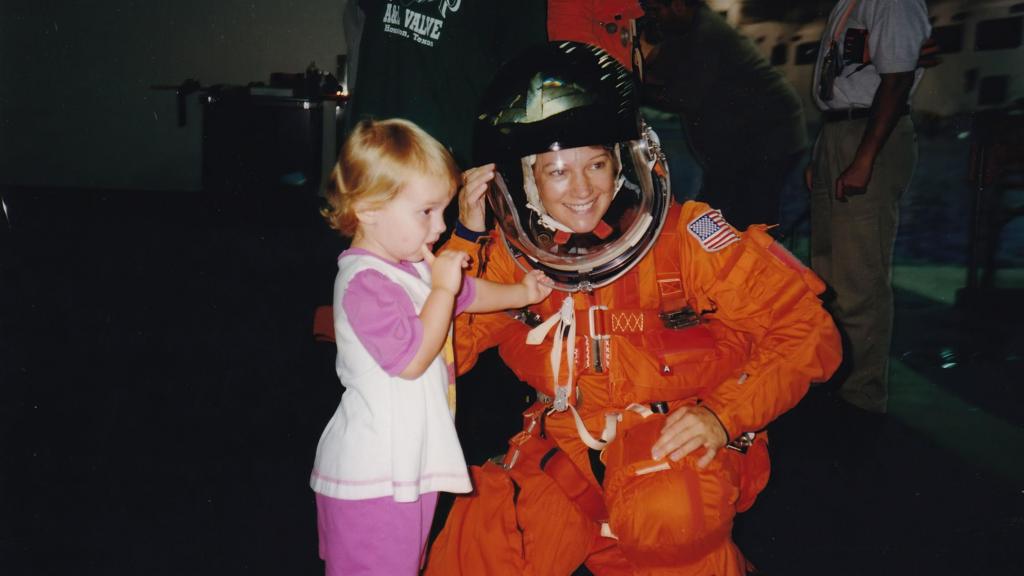“`html
She shattered the glass ceiling and continued to soar. Eileen Collins made history as the first woman to pilot and command a NASA spacecraft. Despite her groundbreaking achievements, her name remains unfamiliar to some.
A new feature-length documentary, “Spacewoman,” chronicles her trailblazing career and aims to rectify this.
At London’s Science Museum, Collins is soft-spoken, warm, and grounded, yet her focus and determination are palpable. She possesses an undeniable inner strength.
“I was reading a magazine article on the Gemini astronauts. I was probably nine years old, and I thought that’s the coolest thing. That’s what I want to do,” she recalls.
“Of course, there were no women astronauts back then. But I just thought, I’ll be a lady astronaut.”
That ambition evolved into a desire to command a spacecraft.
Achieving this required joining the military and becoming a test pilot.
In the Air Force, her exceptional abilities led to her selection for the astronaut program, piloting NASA’s reusable “space planes,” the Space Shuttles.
During her first mission in 1995, she felt the weight of global scrutiny.
“As the first woman to pilot the Space Shuttle, I worked very hard at that because I didn’t want people to say, ‘Oh look, the woman has made a mistake’. Because it wasn’t just about me, it was about the women to follow me,” she explains.
“And I wanted there to be a reputation for women pilots that was: ‘Hey, they’re really good’.”
Her performance led to her promotion to commander, another historic first.
As a wife and mother of two, Collins faced questions in press conferences about balancing her personal and professional lives, with journalists seemingly surprised by her ability to excel in both roles.
Collins maintains that being a mother and a commander were “the two best jobs in the world.”
“But I’m going to tell you it is harder to be a parent than to be a space shuttle commander,” she jokes.
“The best training I ever had for being a commander was being a parent – because you have to learn how to say no to people.”
The Space Shuttle program, spanning three decades, witnessed both extraordinary successes and devastating tragedies.
The Challenger disaster in 1986, which occurred moments after launch, claimed the lives of all seven crew members.
In 2003, the Columbia shuttle disintegrated upon re-entry over Texas, resulting in another crew of seven perishing.
A piece of insulating foam detached from Columbia’s fuel tank during launch, damaging the heat shield and causing the catastrophic failure.
The shuttle could not withstand the intense heat of re-entry and disintegrated before the world’s eyes.
Collins reflects somberly on the disaster and the loss of her friends.
As commander, she was tasked with leading the subsequent shuttle flight.
Did she consider resigning at that point?
“People throughout the shuttle programme were counting on the commander to stick with it,” she states quietly.
“I think quitting the mission would have been the opposite of brave… and I wanted to be a brave leader. I wanted to be a confident leader. I wanted to instill that confidence in other people.”
During her mission in 2005, a similar incident occurred: foam broke away during launch.
This time, a plan was in place to assess the damage, requiring an unprecedented maneuver.
Collins had to pilot the shuttle through a 360-degree flip while docked beneath the International Space Station, allowing crew members to photograph the shuttle’s underside to check for breaches in the heat shield.
“There were engineers and managers saying it couldn’t be done, all these reasons why it was too dangerous,” she recounts.
“I listened to the discussion, they knew I was the commander, and I said: ‘It sounds like we can do it’.”
With steady hands and a calm voice, Collins executed the slow, graceful somersault. The photographs revealed damage, and a spacewalk was conducted for repairs.
Collins and her crew returned home safely.
This was Collins’s final flight. She had always intended to retire after her fourth mission to allow others the opportunity to experience space.
Having observed many astronauts follow in her footsteps, what advice does she offer the next generation?
“Do your homework, listen to your teacher, pay attention in class and read books, and that will give you something to focus on,” she advises pragmatically.
Future astronauts will learn about Collins’s achievements, not only as a woman but as a remarkable pilot and commander.
She has no regrets about ending her astronaut career, standing by her decision. However, a hint of longing appears when asked if she would accept a seat on a spacecraft if offered.
“Yes, I would love to go on a mission someday. When I’m an old lady, maybe I’ll get a chance to go back in space.”
“Spacewoman” is now playing in select cinemas.
The rocket launched from Starbase, Texas and flew for more than an hour before splash landing into the Indian Ocean.
The missing Nasa research-probe had blown off course and crash-landed in Edmonson on 2 October.
The space probe had launched from the Columbia Scientific Balloon Facility in New Mexico before it was blown off course.
The Euclid satellite, launched by Space X, was developed by a team including Professor Adam Amara.
Astronauts of Nasa’s first crewed mission to the Moon for more than 50 years hope their journey inspires a new generation.
“`

